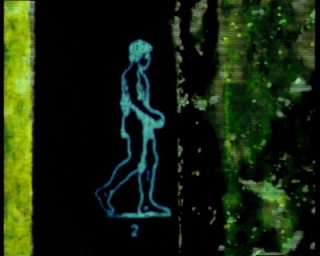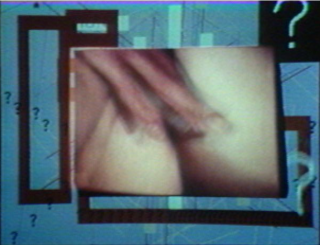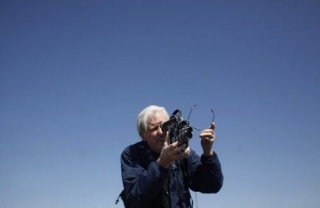Date: 14 January 2004 | Season: LUX Salon
LUX SALON: DIRK DE BRUYN: ANCIENT DAMAGE
Wednesday 14 January 2004, at 7:30pm
London LUX
Born in the Netherlands, Dirk de Bruyn has been active as an artist, writer and organiser for over 30 years, primarily in Australia where he has been a central figure in the Melbourne film scene. De Bruyn uses a variety of techniques including direct animation, flicker, time lapse and hand-processing to create dynamic personal cinema. This programme features a film from each decade and includes the world premiere of Analog Stress.
Dirk de Bruyn, Running, 1976, colour, sound, 30 min
Dirk de Bruyn, Boerdery, 1985, colour, sound, 11 min
Dirk de Bruyn, Rote Movie, 1994, colour, sound, 12 min
Dirk de Bruyn, Analog Stress, 2004, colour, sound, 12 min
PROGRAMME NOTES
LUX SALON: DIRK DE BRUYN: ANCIENT DAMAGE
Wednesday 14 January 2004, at 7:30pm
London LUX
RUNNING
Dirk de Bruyn, 1976, 16mm, colour, sound, 30 min
The reworking repetition and reprocessing of a strip of film of two people walking down a lane. The flashing positive and negative images force the viewer to stare rather than looking at the film. Made at a time when the filmmaker had access to a professional processing machine and chemicals.
BOERDERY
Dirk de Bruyn, 1985, 16mm, colour, sound, 11 min
A time-lapse document of a farmhouse in the Netherlands mapping the changing seasons, the light and shadows. Made with an interval-meter fashioned out of a wind screen wiper motor. Music by Chris Knowles
ROTE MOVIE
Dirk de Bruyn, 1994, 16mm, colour, sound, 12 min
“On the voice over de Bruyn places himself behind the wheel of a car, an appropriate metaphor for his expatriate driven reflections on his feelings of exile, distance and loneliness. Necessarily unintelligent memories highlight habitual subjectivity of “walking through a landscape alone”, “gypsy”, “victim”. Images of road signs, cars, billboards, the passing landscape; elegantly simple rotoscope (by rote?) drawings, recopied and texturally manipulated filmic images; the inevitability of the repetition of leader. A tired, yearning, moving film.” —Steven Ball, Mesh 3, Autumn 1994
ANALOG STRESS
Dirk de Bruyn, 2004, 16mm, colour, sound, 12 min
Made from reworked and reanimated found industrial and discarded personal footage. The main focus is the soundtrack which has been reconstructed from scratches, pen marks, Letraset strips and the music and phrases of found films.
Back to top
Date: 3 February 2004 | Season: LUX Salon
LUX SALON: BJØRN MELHUS
Tuesday 3 Februry 2004, at 7:30pm
London LUX
Bjørn Melhus is a media artist who reprocesses recognisable elements of American culture, feature films and daytime television into a humorous, but unsettling, reflection of modern life. From his 16mm student films and early videotapes, through to his more recent, technically seamless, digital productions, Melhus has continued to explore the boundaries between the real world and its fictional counterpart. Further blurring our perception, he performs as every character in each, building a dizzying repertory of doppelgangers.
Bjørn Melhus, Das Zauberglas, 1991, colour, sound, 6 min
Bjørn Melhus, No Sunshine, 1997, colour, sound, 6 min
Bjørn Melhus, The Oral Thing, 2001, colour, sound, 8 min
Bjørn Melhus, Auto Center Drive, 2003, colour, sound, 28 min
Bjørn Melhus, Cornflakes, 1987, colour, sound, 2 min
The screening will begin with documentation of Bjørn Melhus’ installation Primetime (2001).
PROGRAMME NOTES
LUX SALON: BJØRN MELHUS
Tuesday 3 Februry 2004, at 7:30pm
London LUX
DAS ZAUBERGLAS (THE MAGIC GLASS)
Bjørn Melhus, 1991, colour, sound, 6 min
“Like Faust in the witch’s kitchen scene, who sees a heavenly image in a magic mirror and recognises the model of all women who awaken his longing, the man in Das Zauberglas also experiences longing and joy when he encounters his female alter ego in the 20th century’s magic mirror – the television screen. But here the joy is not enduring, and is ultimately foiled by the parameters of a media world” —Barbara Nierhoff
NO SUNSHINE
Bjørn Melhus, 1997, colour, sound, 6 min
“The basis of all my work is a previously composed sound and speech collage, often set to a rhythm, and certainly quotes fragments of an already present pop culture. They are nevertheless not pop music at all. They do not bear any musical product or any sort of lifestyle ideology, and shouldn’t either, although they certainly confront this.” —Bjørn Melhus
THE ORAL THING
Bjørn Melhus, 2001, colour, sound, 8 min
“In The Oral Thing, Melhus plays a cast of weird characters in a disturbing spiritual self-help parody using game and talk show sound bytes. The ‘host’ offers redemption, while the ‘guests’ confess terrible secrets in front of an ‘audience’ of hooded clones.” —William Powhida
AUTO CENTER DRIVE
Bjørn Melhus, 2003, colour, sound, 28 min
“The film plays at different levels. In addition to a very personal, metaphoric narration, it deals with the construction and deconstruction of the ego. In Western culture the ego is an invention based on media projections, just as the suburban surroundings seem to increasingle follow a script” —International Kurzfilmage Oberhausen
CORNFLAKES
Bjørn Melhus, Cornflakes, 1987, colour, sound, 2 min
An early 16mm film on the subject of consumption and commercials. Made at the Braunschweig School of Arts, shown tonight just for fun.
Bjørn Melhus’ first British solo show “Primetime” is at FACT Liverpool until 7 March 2004.
This LUX Salon is presented in association with the Serpentine Gallery to coincide with their current exhibition “State of Play” (3 February – 28 March 2004). The exhibition presents the work of international artists who play with ideas and situations. At a time when art can no longer be defined through a single dominant movement or school of thought, the exhibition identifies a number of artists who share an attitude of irreverence and wit, and a lightness of touch increasingly visible in contemporary art making today. Featuring Maurizio Cattelan, Martin Creed, Tony Feher, Bjørn Melhus, Aleksandra Mir, Tim Noble and Sue Webster, Pipilotti Rist, David Shrigley, Andreas Slominski and Sarah Sze. Curated by Rochelle Steiner.
Back to top
Date: 30 March 2004 | Season: LUX Salon | Tags: London Lesbian & Gay Film Festival
LUX SALON: BARBARA HAMMER
Tuesday 30 March 2004, at 7:30pm
London LUX
Barbara Hammer, is an internationally recognised film artist who has made over eighty films and videos, and is considered a pioneer of lesbian-feminist experimental cinema.
Barbara Hammer, Dyketactics, 1974, colour, sound, 4 min
Barbara Hammer, Multiple Orgasm, 1977, colour, sound, 6 min
Barbara Hammer, Double Strength, 1978, colour, sound, 16 min
Barbara Hammer, Our Trip, 1980, colour, sound, 4 min
Barbara Hammer, Sync Touch, 1981, colour, sound, 10 min
Barbara Hammer, No No Nooky T.V., 1987, b/w & colour, sound, 12 min
“To discover and uncover the invisible images and material in photography, film and video has been my pursuit for over twenty-five years as a pioneer lesbian artist. I have made over seventy-seven film and videos since 1972. All my work is about revealing, showing, expressing, uncovering that which has not been seen before. I try to give voice and image to those who have been denied personal expression. I continue to be involved in formal structure determined by the content of the material. Over the years my films and videos have evolved to dense referential montages characterised by a challenging montage/collage of image and audio. I seek to empower the viewing audience to “make their own film” by working in a non-linear, metaphoric and fragmented manner. It is a political act to work and speak as a lesbian artist in the dominant art world and to speak as an avant-garde artist to a lesbian and gay audience. My presence and voice address both issues of homophobia as well as the need for an emerging community to explore a new imagination.” (Barbara Hammer)
PROGRAMME NOTES
LUX SALON: BARBARA HAMMER
Tuesday 30 March 2004, at 7:30pm
London LUX
DYKETACTICS
Barbara Hammer, 1974, colour, sound, 4 min
The first lesbian lovemaking film to be made by a lesbian filmmaker. Sensual, evocative montage of 110 images selected for their representation of ‘touching’. In the words of the filmmaker, “I wanted to make a lesbian commercial.”
“The images are varied and very quickly presented in the early part of the film, introducing the characters, if you will. The second half of the film slows down measurably and all of a sudden I found myself holding my breath as I watched the images of love-making sensually and artistically captured.” (Elizabeth Lay, Plexus)
MULTIPLE ORGASM
Barbara Hammer, 1977, colour, sound, 6 min
A sensual, explicit film that says just what it is, plus visual overlays of erotic rock and cave formations.
DOUBLE STRENGTH
Barbara Hammer, 1978, colour, sound, 16 min
“One of Barbara’s most beautiful films on personal relationships made with trapeze artist Terry Sendgraff, shot swinging in the nude from various angles. The image poetry carries us through the duration of a relationship: its intensely erotic beginnings, its sense of serenity, its playfulness and comedy, and its closure, the alienation, pain, anger, and loss of contact. The death of the body, a theme tenderly interwoven into the ageless strength and agility of Terry Sendgraff’s body, becomes the death of a relationship, a closing out, a blanking out, a leaving of the body behind. The body becomes a source of life. Its movement, grace, pain, and happiness are contrasted with the inertness of things and the stillness of photos that merely document the brief passage of light.” (Jacqueline Zita, Jumpcut)
OUR TRIP
Barbara Hammer, 1980, colour, sound, 4 min
“Feminist filmmaker Barbara Hammer has celebrated her recent trip to Peru with her friend Corky Wick through a diaristic animation of photographs they took during their travels. Landscapes and portraits are given growing patterns of framing and texture with magic markers and tempera paint, expressing the richly evocative folk art of the Incan people they saw as we hear their native music resonate on the soundtrack.” (Anthony Reveaux)
SYNC TOUCH
Barbara Hammer, 1981, colour, sound, 10 min
“At the opening we are listening to an ‘expert’ speaking – someone who knows about touch and erogenous zones, about the erotic – yet the emphasis is on her ‘knowing’ and what she knows ‘about’ rather than on her ‘experiencing.’ Hammer undercuts the monologue with intense and extraordinary close-ups of areas of the woman’s face and neck, her teeth and lips, her ears. The viewer becomes so absorbed in the details of this closeness, the closeness of a lover seeing the face of her friend, that the words become lost in feeling and experiencing the closeness itself. The other way this works is to make the viewer want to touch, to become involved for, as the speaker says, touch precedes sight in the new-born child, and sight becomes a connection between the actual touch and understanding what it means.” (Cath Dunsford, Alternative Cinema)
NO NO NOOKY T.V.
Barbara Hammer, 1987, b/w & colour, sound, 12 min
Using a 16mm Bolex and Amiga computer, Hammer creates a witty and stunning film about how women view their sexuality versus the way male images of women and sex are perceived. The impact of technology on sexuality and emotion and the sensual self is explored through computer language juxtaposed with everyday colloquial language of sex. No No Nooky T.V. confronts the feminist controversy around sexuality with electronic language, pixels and interface. Even the monitor is eroticised in this film/video hybrid that points fun at romance, sexuality, and love in our post-industrial age.
Presented in association with the London Lesbian & Gay Film Festival, with thanks to Selina Robertson.
Back to top
Date: 23 June 2004 | Season: LUX Salon
LUX SALON: STATE OF THE UNION: BRUCE BAILLIE & LENKA CLAYTON
Wednesday 23 June 2004, at 7:30pm
London LUX
A US election year special. LUX is pleased to present a new print of Bruce Baillie’s legendary American travelogue Quixote, made coast-to-coast over a four year period. Baillie’s film is a lyrical, patchwork portrait of the margins of 60s America, from the supermarket aisles to the circus big top.
“Baillie’s trip is wedged between two generations of youthful nomads; the Beats (contemporaneous with Hollywood’s heydey of Western expansion) on one side, the hippy transhumances (and Easy Rider) on the other. That Quixote could be claimed, at different times, by each is a sign of its hinged position to two vastly different projects.” —Paul Arthur.
Lenka Clayton’s concept in Qaeda Quality Question Quickly Quickly Quiet was a simple one – take the 4,100 words from George W.Bush’s infamous “Axis of Evil” speech, and splice them together in alphabetical order. The result is powerful: a mesmerising snapshot of the posturing, rhetoric and obsessions dominating American politics in the aftermath of 11 September.
Bruce Baillie, Quixote, USA, 1964-67, 16mm, b/w & colour, sound,
Lenka Clayton, Qaeda Quality Question Quickly Quickly Quiet, Germany, 2003, video, colour, sound, 18 min
Date: 8 November 2004 | Season: LUX Salon
LUX SALON: JEROME HILER
Monday 8 November 2004, at 7:30pm
London LUX
Film artist Jerome Hiler presents a rare 16mm work-in-progress screening of In the Stone House, a project he has been working on since the 1960s.
“The film I am presenting is composed mainly from spontaneous renderings of ordinary life. My method was to work directly with the Bolex camera as a sort of transformation device rather than to dream up some sort of plan and execute that. The moments of vision in the film, be they insightful or mundane, are joined by moments of complete blackout. These blackouts, which are like the blinking of an inner eye, create discontinuity and flow at the same time.
My experience as an artist has shown me that the work produced has been like a mirror held up to myself rather than to nature. My memory of the day before yesterday is already spotty and I have no idea what the next hour will bring. I actually can see myself bumbling from event to event in my life thanks to the very effort I make to establish sense and order in my film. The film, then, is a reflection of that fabulous combination of brilliance in the moment and desperate hoping for the best as it steps forward into unknown territory.”
Jerome Hiler




